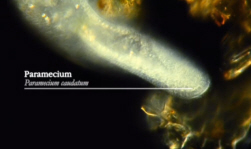Paramecium candatum
Electrical Sensing
What is Life?

Paramecium candatum
Now that is a Paramecium. It may look like a simple animal, but in fact it's a member of the group of organisms called protists. You'd have to go
back around 2 billion years to find a common ancestor between me and a Paramecium.
Paramecia have probably changed little in the last billion years. Although they appear simple, these tiny creatures display some remarkably complex
behaviour. You can even see them responding to their environment.
The cell swims around, powered by a cohort of cilia, tiny hairs embedded in the cell membrane. If it bumps into something, the cilia change direction
and it reverses away. They're clearly demonstrating a sense of touch. Even though they're single-celled organisms, they have no central nervous system,
they can still do what all life does. They can sense their environment and they can react to it, and they do that using electricity.
The mechanism that powers the Paramecium's touch response lies at the heart of all sensing animals. And it's based on an electrical phenomenon
found throughout nature.

Wind Vane
An electric current is a flow of electric charge, and for that to happen, you need an imbalance between positive and negative charges. Now,
usually in nature, things are electrically neutral, the positive and negative charges exactly balance out, but there are natural phenomena in
which there is a separation of electric charge. A thunderstorm, for example.
As thunderclouds build, updraughts within them separate charge. The lighter ice and water crystals become positively charged and are carried
upwards, while the heavier, negatively charged crystals sink to the bottom. This can create a potential difference, volts between the cloud and
the ground of as much as 100 million volts.
Now, nature abhors a gradient. It doesn't like an imbalance, and it tries to correct it by having an electric current flow. In the case of a
thunderstorm, that's a bolt of lightning.
And it's the same process that governs the Paramecium's behaviour, but on a tiny scale. In common with virtually all other cells, and certainly
all animal cells, the Paramecium maintains a potential difference across its cell membrane.

"Professor Brian Cox
It does that in common with a thunderstorm by charge separation. By manipulating the number of positive ions inside and outside its membrane,
the Paramecium creates a potential difference of just 40 millivolts. So when a Paramecium is just sat there, not bumping into anything, floating
in this liquid, then it's like a little battery. It's maintaining the potential difference across its cell membrane, and it can use that to
sense its surroundings.
When it bumps into something, its cell membrane deforms, opening channels that allow positive ions to flood back across the membranes. As the
potential difference falls, it sets off an electrical pulse that triggers the cilia to start beating in the opposite direction. That electrical
pulse spreads around the whole cell in a wave called an action potential. And the Paramecium reverses out of trouble.
This ability to precisely control flows of electric charge across a membrane is not unique to the Paramecium. It actually lies at the heart of
all animal senses. In fact, every time I sense anything in the world, with my eyes, with my ears, with my fingers, at some point between that
sensation and my brain, something very similar to that will happen.
Although the same electrical mechanism underpins all sensing, every animal has a different suite of sensory capabilities that is beautifully
adapted to the environment it lives in.


